
Cranberry Hibiscus
Hibiscus acetosella
Basic Information
🌿 Family: Malvaceae🗺️ Zone: 8-11
Other Names:
- African Rosemallow
- False Roselle
- Red Leaf Hibiscus
🌡️ Ideal Temperature : 70°F – 90°F
🔥 Heat Tolerance: Up to 100°F
❄️ Cold Tolerance: Down to 35°F
🌱 Type: Perennial
Layers
- Shrub
Functions
- Edible
- Medicinal
- Pollinator
- Wildlife Attractor
- Mulcher
- Dynamic Accumulator
- Border Plant
Pests
No pests associated with this plant.
Description
Cranberry Hibiscus is a fast-growing perennial shrub that reaches 1.5-2 meters (5-7 feet) in height. It is known for its striking deep burgundy, maple-like leaves and bright pink to red flowers. Unlike Roselle (*Hibiscus sabdariffa*), the flowers of Cranberry Hibiscus are not commonly used for tea, but the young leaves are edible and have a tart, lemony flavor. This plant thrives in warm climates and is commonly grown as an ornamental due to its vibrant foliage.
🌞💧 Sun and Water Requirements:
Cranberry Hibiscus prefers full sun but can tolerate partial shade. It thrives in well-drained, moderately fertile soils with regular watering. While it is somewhat drought-tolerant, consistent moisture improves growth and leaf production.
✂️🫘 Methods to Propagate:
Cranberry Hibiscus is best propagated through seeds or stem cuttings. Directly sow seeds in warm soil after the last frost, or start them indoors 6-8 weeks before transplanting. Cuttings taken from mature stems root easily in moist soil.
🧑🌾👩🌾 When to Harvest:
Leaves can be harvested throughout the growing season when young and tender for fresh use in salads or cooking. Flowers bloom in late summer to fall and can also be collected for ornamental use. The plant often reseeds itself if allowed.
Purpose
- **Edible:** Young leaves are rich in antioxidants and have a tangy, citrus-like flavor, commonly used in salads or cooked dishes.
- **Medicinal:** Traditionally used for its high anthocyanin content, which provides anti-inflammatory and antioxidant benefits.
- **Pollinator:** The bright red flowers attract bees, butterflies, and hummingbirds, supporting pollination.
- **Wildlife Attractor:** Provides nectar for beneficial insects and can be a food source for small herbivores.
- **Mulcher:** Leaves and stems decompose quickly, adding organic matter to the soil.
- **Dynamic Accumulator:** Helps accumulate nutrients in the soil, benefiting nearby plants.
- **Border Plant:** Its striking foliage makes it an excellent hedge or border plant in gardens.